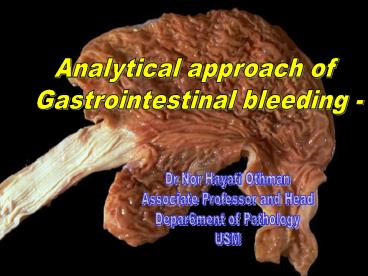Analytical approach of PowerPoint PPT Presentation
1 / 32
Title: Analytical approach of
1
Analytical approach of Gastrointestinal bleeding
-
Dr Nor Hayati Othman Associate Professor and
Head Depar6ment of Pathology USM
2
(No Transcript)
3
GASTROINTESTINAL CIRCULATION
Celiac axis superior mesentric artery inferior
mesentric artery anastomotic connections
Anastomotic connections sup.and inf pancreatico
duodenal a. marginal a. of Drummond arc of
Riolan splenic flexure
4
Embryology/anatomy/histology
- STOMACH
- Derived from foregut
- 4 anatomic parts cardia, fundus, body, pylorus
- 3 layers of wall mucosa (include muscularis
mucosa), - submucosa, muscularis propia
- 3 layers of muscle coat longitudinal, circular
and oblique - Variable mobility body mucosa - rugose and
freely mobile - antral mucosa firmly anchored
- Generous arterial blood supply coeliac, hepatic,
splenic - Abundant arterial anastomosis-EXCEPT lesser curve
and - 1st part duodenum
- Distinct mucosalarterial vasculature - supplied
by extramural - end arteries
5
Why do patients bleed?
- Due to mass effect
- Not due to mass effect
6
Due to mass effect
- Mass erodes blood vessels
- Mass alters the normal route of the vessels
- Mass is accompanied by growth of numerous
abnormal , fragile vascular channels - Mass is of vascular origin
7
Not due to mass effect
- Lesions that ulcerate the GI mucosa
- GI Ischaemia/infarction
- GI Varices
- GI infestation/infection
- Liver diseases
- Pancreatitis
- Bleeding diathesis
- Drugs
8
Mass eroding blood vessels
Mucosal lesions - eg adenoca of stomach Mural
lesions - eg GIST, lymphoma Tumours with
angioinvasive potential- eg choriocarcinoma(20)
mech of bleeding
GIST gastrointestinal stromal tumour mass
arising fr the mesenchymal coat push and
stretch the surface mucosa surface mucosa
ulcerate
9
GIST ulcerating the mucosa
mucosa
Benign of malignant GIST, effect on mucosa is
similar rate of growth differ
10
Mass altering the route of mucosal blood vessels
gastrointetinal polyps- neoplastic
(adenomas)- tubular, - villus,
- tubulovillous non neoplastic
hyperplastic regenerative, inflammatory,
harmatomatous
-
11
mech of bleeding
gastrointetinal polyps- bleeding both from the
sessile and pedunculated new
vessels from original vessels
mucosal vessels tortuous
young mucosa (fragile) protrude into lumen
easily ulcerate
-
12
adenoma
Risk of bleeding Villous gt tubular villous gt
tubular
13
Mass accompanied by growth of abnormally fragile
vessels
Mucosal lesions - Adenocarcinoma Neuroendocr
ine carcinoma Mural lesions Carcinoid
tumours Gastrointestinal stromal tumours
(GIST) Lymphomas PNET Inflammatory fibroid
polyp Fibrohistiocytic tm Endothelial/vascular
tumours
14
Mass accompanied by growth of abnormally fragile
vessels
mech of bleeding
- Growing tumour secrete angiogenetic factor
- Many new cappilaries are formed
- The rate of vasc formation is // to degree of
differentiation - The faster these vessels are formed, the more
fragile they are
15
Mass of vascular origin
Non Neoplastic Primary vessel disease Large
vessel disease Small vessels Ds Vascular
malformations Vascular ectasia AVM Neoplastic
hemangiomas hemangiosarcomas Lymphangiomas Kap
osis sarcomas
16
Large vessel disease Polyarteritis
Nodusa Takayasus disease, Giant cell
arteritis Thromboangitis obliterans Small
vessels Ds HSP Connective Ts Ds GI
Fibromuscular dysplasia Wegerners
Granolomatosis
17
- Polyarteritis Nodusa
- Systemic disorder
- GI involvement 50 of cases
- Involve medium sized mesentric vessels
- aneurysmal dilation if only a segment of the vs
affected - Us. intra-abd or retroperitoneal bleeding
- may thrombosed ---gt mucosal ulceration
- charecteristic histology
18
- Connective tissue disease
- SLE, RA, Scleroderma, dermatomyositis
- Vasculitis----gt
- mucosal ulceration, infarction,perforation
- histology small and large artery-- obliterative
endarteritis with or without fibrinoid necrosis
19
- Vascular ectasia
- elderly
- right colon, stomach
- terms - angiomas, angiodysplasia, avms
- Associated with aortic stenosis, von Willibrand
ds - grossly - small, multiple
- easily identified but angiography but not biopsy
- Pathogenesis not clear - postulation due to low
grade obstruction of submucosal colonic veins---gt
leading to loss of precappilary sphincter----gtav
shunts---gtectatic channels
20
I am yawning!!
21
Not due to mass effect
Lesions ulcerating mucosa erosive/hemorrhagic
gastritis Reflux disease Barrets
esophagitis Peptic ulcer disease
22
Not due to mass effect
normal
Erosive hemorrhagic gastritis
Peptic ulcer
23
mech of bleeding
- Erosive hemorrhagic gastritis/peptic ulcer
disease - critically ill patients
- NSAID, active alcoholics, drugs
- Loss of maintainence of mucosal intergrity
24
mech of bleeding
- Maintainence of mucosal intergrity
- Mucus and bicarbonate action
- Prostaglandins
- Mucus and bicarbonate action
- mucus from surface and neck columnar cells
- glycoprotein gel coat the surface
- bicarbonate fr. Surface epith cells
--gtglycoprotein gel - mucus neutralize hydrogen ions that diffuse from
the lumen into the mucus gel - mucosa is in contact with neutral fluid,
regardless the amount of acid
25
mech of bleeding
- Prostaglandins
- protect gastric mucosa -----gt cytoprotection
(mucosal protection) - how ?
- Increase in bicarbonate and mucus secretion
- increase blood flow
- increase cell renewal
26
mech of bleeding
- Erosive hemorrhagic gastritis/peptic ulcer
disease - critically ill patients
- NSAID, active alcoholics, drugs
- Loss of maintainence of mucosal intergrity
- Mucous and bicarbonate secretion by surface
epith. - Loss of glycoprotein gel which adheres to surface
- Loss of acid neutralizer action by bicarbonate
27
GASTROINTESTINAL ISCHAEMIA /INFARCTION
mech of bleeding
hypoxia, throboembolic ds vasoconstriction etc,
ischaemia necrotic mucosa/underlying wall
including vessels shed of GI bleeding
28
GASTROINTESTINAL ISCHAEMIA /INFARCTION
infarcted
normal
29
(No Transcript)
30
- SUMMARY
- GI bleeding can be caused by
- masses in the gastrointestinal tract
- eroding the mucosal vessels
- altering the normal course of the vessels
- forming fragile vessels
- destroying resident vessels
- vascular in origin
31
- SUMMARY
- GI bleeding can be caused by
- no masses in the gastrointestinal tract
- diffuse ulcerative lesions
- disturbance in its vascular supply such as
infarction/ischaemia - variceal formation due to liver disease and
portal hypertension - systemic diseases such as connective tissue
diseases - Bleeding diasthesis due to DIVC as a result of
stress,coagulation disorders etc
32
Thank you

